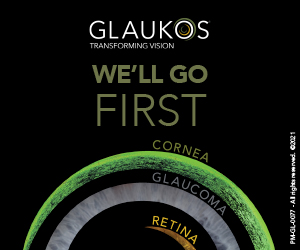Glaucoma research review – December 2024
The glaucoma intensive treatment study (GITS): comparing intensive and standard treatment on five years’ visual field development
B. Bengtsson et al
Am J Ophthalmol. 2024 Oct;266:274-288
Review: We know that lower intraocular pressures (IOPs) are associated with less visual field progression, yet most treatment strategies start with monotherapy. This begs the question: would patients have better long-term outcomes if they had more intensive IOP-lowering treatment initially, rather than a stepwise escalation?
Conducted in Sweden, this randomised controlled trial involved 242 patients with newly diagnosed open-angle glaucoma. Patients were assigned to either multiple medications and laser trabeculoplasty, or monotherapy, where treatment was escalated as needed. The primary outcome measure was visual field index (VFI) at five years.
The study found that patients in the multi-treatment group experienced slower visual field progression, with a 0.25% annual loss compared to 0.65% in the mono-treatment group. The multi-treatment group also had a lower percentage of participants (11%) experiencing visual field progression compared to the monotherapy group (21%). Differences in visual field outcomes were more significant in patients with higher baseline IOP. Adverse events were more common in the multi-treatment group, though most were mild.
Comment: This study suggests that intensive treatment may be helpful for patients with high untreated IOP, but the authors do not recommend using this approach for all glaucoma patients.
Responsiveness to SLT in open-angle glaucoma and ocular hypertension
Yangfan Yang et al
JAMA Ophthalmol. 2024;142(10):918-924
Review: The laser in glaucoma and ocular hypertension (LiGHT) study, published in 2019, marked a significant shift in the management of newly diagnosed early primary open-angle glaucoma and ocular hypertension. Selective laser trabeculoplasty (SLT) was demonstrated to be at least as effective as monotherapy with eye drops for lowering IOP and more cost-effective within a public health service context. In 2023, findings from the six-year extension of the study confirmed these effects could be sustained in 74% of patients. However, the LiGHT study did not specifically address the optimal management of patients who exhibited no or insufficient IOP reduction following initial SLT treatment.
Based on the UK-based LiGHT study design, a sister trial was initiated in China. This included an additional protocol to explore this clinical question. Of the 771 participants in the original cohort, 105 patients (180 eyes) underwent repeat SLT following initial treatment failure, regardless of their initial IOP-lowering response. The mean IOP reduction following repeat SLT was comparable to the initial treatment, but with a significantly longer duration of effect (1,043 days vs 419 days). However, 15% of eyes remained non-responsive to the second SLT treatment. Greater age, female sex and initial non-response increased the likelihood of second treatment failure.
Comment: Repeat SLT can be offered to patients experiencing early treatment failure and may also be considered in patients initially deemed non-responsive to the first SLT treatment.
Fourteen-year outcome of angle-closure prevention with laser iridotomy in the ZAP study
Yixiong Yuan et al
Ophthalmology. 2023 Aug;130(8):786-794
Review: The Zhongshan angle-closure prevention study (ZAP) is a long-term randomised controlled
clinical trial examining the effects of laser peripheral iridotomy (LPI) on preventing primary angle closure (PAC) in Chinese patients aged 50-70 with primary angle-closure suspect (PACS). The study randomly treated one eye of each participant with LPI, while the other eye served as a control. The original study reported six years’ data and included 889 participants, and showed LPI halves the risk of PAC, but the results showed surprisingly low rates of both conversion to PAC (4.1%) and acute angle closure (0.4%).
Unsurprisingly, after 14 years of follow-up, in 500 patients, the study found increased rates of PAC in both groups. LPI significantly lowered the risk of PAC, reducing it by about two-thirds compared to untreated eyes. Of the eyes treated with LPI, 33 reached the PAC endpoint, while 105 untreated control eyes did. However, mild peripheral anterior synechiae was the most common endpoint, with only 0.7% untreated eyes developing raised intraocular pressure at 14 years. While LPI was effective in reducing PAC progression, it was associated with slightly higher IOP and an increased risk of cataracts in treated eyes.
Comment: The overall risk of glaucoma was low, suggesting that prophylactic LPI may not be necessary for all PACS patients.

Dr Dan Gosling is a cataract and glaucoma surgeon consulting in Auckland at Milford Eye Clinic and Greenlane Clinical Centre.





















